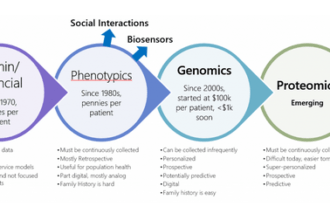Does it really have an impact on the success of your telehealth program, product, or solution?
If so, where does it have impact?
How can you influence that impact?
For answers to these questions, I went to a leading authority on telehealth public policy – Gary Capistrant, the Senior Director for Public Policy at the American Telemedicine Association.
Does it really have an impact on the success of your telehealth program, product, or solution?
If so, where does it have impact?
How can you influence that impact?
For answers to these questions, I went to a leading authority on telehealth public policy – Gary Capistrant, the Senior Director for Public Policy at the American Telemedicine Association.
Gary’s health policy expertise spans 30 years with Medicare, Medicaid, and health reform.
In this discussion, Gary educates us on what public policy involves so that instead of fearing it, we can learn how to benefit from it or leverage it to support our goals.
Nirav: For people who are new to public policy, can you explain why public policy matters and how it impacts telemedicine?
Gary:
Public policy influences a number of areas that affect telehealth and telemedicine. Among the most important are:
- Reimbursement – which, in the fee-for-service model used in the United States healthcare system, addresses whether or not insurers will cover for telehealth consultations and / or related activities. Reimbursement guidelines start with government-provided insurers CMS (the Centers for Medicare and Medicaid Services) and can also impact private insurers.
- Licensure – which controls where clinical professionals are legally allowed to practice their clinical specialty.
- Regulatory – which guides how telehealth products can be used and what level of regulatory approvals they need (e.g. from the FDA) in order to be deemed safe and effective for use in clinical environments.
- Funding – which provides monetary resources to build out telehealth programs
- Legal – there are many laws related to the practice of medicine. Some of these can become even easier to risk breaking when practicing telemedicine. For example, the Stark law, anti-referral, and anti-kickback laws are important areas.
The challenge in public policy is that while government does support telehealth in some ways, in other ways it erects artificial barriers which slow down or halt the growth of telehealth.
Nirav: You mention artificial barriers. What artificial barriers to telehealth has government put in place?
Gary:
For one, reimbursement. Physicians are justifiably not inclined to spend their time on telemedicine consults which may result in minimal or non-reimbursement as compared to in-person consults that would get fully reimbursed.
CMS is making some strides towards this, particularly with Medicaid programs.
But until telemedicine-related revenues are equivalent to in-person consult revenues (in the fee-for-service model that dominates the current US healthcare system), there will always be resistance to telemedicine adoption.
Similarly, licensure is an issue.
For example, a physician licensed in New York cannot practice telemedicine across state lines into New Jersey without obtaining a license to practice medicine in that state as well.
Obtaining licenses to practice in different states is both expensive and time-consuming.
The ideal scenario for telemedicine is one license that enables a clinician to extend their expertise all over the country.
Yet state medical boards have not been able to get past their states’ specific concerns with ensuring that physicians practice (remote) medicine in accordance with a state’s specific laws.
In general, the laws and regulations are driven by old standards based on old technological paradigms.
The silver lining is that these will all evolve as technology evolves.
Even the technology we’re able to use today is different from what we used 5 years ago.
So the increasing robustness and information richness of remote consultations will make them more attractive in order to save time, leverage in-demand resources, and bridge barriers to care.
Nirav: What is involved in moving public policy forward?
Gary:
It starts with interest from legislators.
Legislators have often heard about telehealth from their constituents. Some have even had friends or family members get treated by telehealth.
So given the benefits they have heard about or seen firsthand, they are interested in getting a better understanding of how to improve access to care.
Sometimes they will take it up at local level. Other times at a regional or national level.
A lot of times, it is a long process of educating and building up support so that when a bill comes up for movement through the legislative process, many of the influencers or decision makers have already been educated about the value of telehealth.
Nirav: What are some areas where public policy has progressed reasonably well?
Gary:
One key area of advance is in physician licensure.
The military serves as a model for enabling physicians to practice telemedicine in support of the military across the entire globe – without requiring licenses to practice in individual states.
Also, there is legislation in place for Veterans Affairs (VA) which will enable physicians to practice telemedicine across all VA facilities.
In addition, there have been some noteworthy advances in state legislation for telemedicine reimbursement.
Currently, 16 states are now requiring telemedicine reimbursement equivalent to in-person consults.
And, the National Organization of Black Elected Legislative women (NOBEL-Women) have taken up legislation for telemedicine reimbursement as one of their leading causes.
They see how telemedicine helps from the standpoint of removing barriers to care from a rural, racial, or socioeconomic standpoint.
Finally, the government has put millions of dollars in funds towards improving healthcare efficiency and quality.
Telehealth is a key beneficiary of these funds because they can provide a springboard for building out broadband infrastructure and making capital purchases for telehealth technology.
Nirav: It’s good to know about government funding as a resource for advancing telehealth initiatives. What are some useful resources to keep track of new funding?
Gary:
Here are a few sites I like to use:
- Grants.gov
- Federal Telemedicine news (published by Bloch Consulting)
- Mobihealthnews (for mobile health)
Nirav: What will really move the needle forward with reimbursement?
Gary:
A major influence will be changing the fee for service model so that a physician’s income is not directly tied to the nature of the consult.
Shared savings, managed care, ACO’s – all of these will help to remove the barriers in adopting telemedicine because there will be an increasing emphasis on quality and on using a set budget to provide the best care for the patient.
Then the physician and the broader health care ecosystem will be free to decide how to best implement that care – whether in-person or not.
Nirav: How can people get involved with advancing public policy?
Gary:
Here are a few simple things they can do…
One is to contribute to the ATA Wiki page. This is a great location for sharing and accessing information about changes and events in public policy.
They could also join the ATA. The ATA has a section call The Hub. People can go through The Hub to join a special interest group in one of the many areas of public policy.
This is a great way to stay abreast of the latest activities in public policy, network with the people involved in moving telehealth public policy forward, and participate in advancing public policy.
In what other ways do you see public policy impacting telehealth? Please share your thoughts below.






